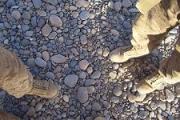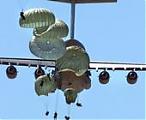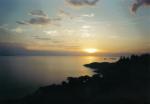I joined the RLI at the beginning of 1980, and so I am no expert on Fire Force. However to answer your questions I can add the following, with an apology for making statements that you have already covered, and repeating the obvious:
Other than Fire Force ops, RLI also carried out the usual patrol, ambush, O.P. operations expected of infantry units. Our use of fire and movement, snap and drake shooting etc, was basically the same regardless of the operation type, the difference being the immediate helicopter assistance available in Fire Force. As far as 90 degree offsets for covering sweep lines are concerned, we generally didn`t use them, although they were certainly part of anti-vehicular ambush drills, and L-shaped ambushes etc.
Obviously, when sweeping, everyone moved forward (reasonably slowly), keeping the line as straight as feasible (a wry smile as I write this). When contact is made the action would depend largely on the distance of the terrs from the troops, immediate action drills dictating the response - together with the nature of the terrain and bush (I don`t actually think you can ever train enough to cover all the possibilities) A very close contact would result in an immediate run through (the thickness of the bush could prevent that), while longer distances would result in drake shooting - emptying 2 magazines each as quickly as accuracy makes possible into likely cover, together with K-car shells etc etc. We would not waste time trying to identify the exact position of the individual terrs (ie looking for muzzle flash etc), although obvious targets would be dispatched immediately. Observation of the target was generally carried out while drake shooting. At some appropriate point the sweep became a skirmish line, ie splitting the sweep into two, the left section (called a flank) goes forward say 20 feet, while the right flank covers. When the left flank goes down, the right flank then moves forward while the left now covers, each troopie Drake shooting when he is part of the covering flank, or firing from the shoulder on the run if he is part of the flank moving forward. At some point both flanks combine to finally run through the terrs position firing from the shoulder. The other skirmish option was called a Pepper-pot, where individuals moved forward in random, each troopie on the ground covering those going forward - NCO`s or junior officers decided the skirmish method, while coordinating with the FFC for the timing of the assault. Pepper-pot (or something that resembled it) was the usual for 4 man sticks.
The overall point of the exercise was for the sweep line to locate the position of hidden terrs, at which point the K-car or Lynx gave them their attention. If an air strike was called for, then our job was to keep their heads down until the strike craft ordered us to stop firing just at the end of his run in (so we didn`t hit him!) The stops, or Stop Groups, were set in place to ambush points of escape, usually dry river beds, obvious paths through thick bush, the saddles in small hills etc, but their overall position was dictated by the FFC, while how the stops ambush was laid out, by their NCO. Stops would not be placed in the immediate front of any sweep line (!) and could often be quite far from the center of attention - A man can run a kilometer in a few minutes when he is frightened. At some point, decided by the FF commander, the stop groups could then be picked up and set elsewhere, or be required to sweep down said saddle, dry river bed etc etc to locate stragglers. When terrs were sited by either sweep or stops groups, or the shooting simply started, a call to the K-car would bring him over, or one or more of the G-cars. When a definite sighting in close proximity was made by troops, we would snap-shoot the target (double tap, or single tap, or a controlled 2-3 round squeeze on fully auto), and then drake shoot as normal. To again state the obvious, the idea was for the sweeps never to walk into each other, or into the stop groups, and all overall movement on the ground is dictated to by the Fire Force Commander. To move around unbidden in the overall combat zone was a definite no no, and would invite unwelcome attention from above - I am aware of at least one occasion when a stick from 1 Commando was attacked by a K-car. Unfortunately I never listened in on the chit chat between FFC and NCO, so cant comment further.
The A76 radios were ok at line of site communication, but they really went to hell in hilly terrain. For example while I had no problem speaking with a helicopter some kilometers away (5-7 km in this instance), the chopper couldn`t raise the other half of my callsign at the foot of the hill I was on - I was a few hundred feet up the side. The Allouette I was talking in onto their location was flying down a river valley at roughly the same altitude as my stick.



 Reply With Quote
Reply With Quote





 , and I said, "Good evening, mine`s a Lion" (a type of beer), and we promptly fled to go find the manager. Although we apparently scared the hell out of everyone
, and I said, "Good evening, mine`s a Lion" (a type of beer), and we promptly fled to go find the manager. Although we apparently scared the hell out of everyone  , they all seemed quite glad to have 4 RLI "troopies" on the premises, as long as we stayed out of their bar and didn`t stink the place up any further! It certainly beat freezing our butts off out in the middle of an African winter when the temperatures can drop easily below freezing, especially in that mountainous area. We never did tell our Troop (Platoon) Officer where we were that night, and the other two sticks of our Troop basically slept in the mountains and froze. Ag man what a shame.
, they all seemed quite glad to have 4 RLI "troopies" on the premises, as long as we stayed out of their bar and didn`t stink the place up any further! It certainly beat freezing our butts off out in the middle of an African winter when the temperatures can drop easily below freezing, especially in that mountainous area. We never did tell our Troop (Platoon) Officer where we were that night, and the other two sticks of our Troop basically slept in the mountains and froze. Ag man what a shame.

Bookmarks